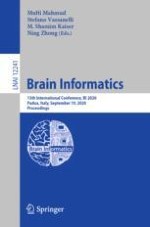This book constitutes the refereed proceedings of the 13th International Conference on Brain Informatics, BI 2020, held in Padua, Italy, in September 2020. The conference was held virtually due to the COVID-19 pandemic.
The 33 full papers were carefully reviewed and selected from 57 submissions. The papers are organized in the following topical sections: cognitive and computational foundations of brain science; investigations of human information processing systems; brain big data analytics, curation and management; informatics paradigms for brain and mental health research; and brain-machine intelligence and brain-inspired computing.
